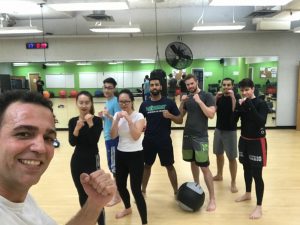
MMA and Rock Climbing Clubs to no longer be ratified
By Katie Czenczek, News Editor
Starting October 1, Douglas College students will no longer be able to punch things and climb to great heights as a part of a club.
After two years of existence, the MMA and DSU Rock Climbing Club will no longer run as of October. This was decided after the DSU formally adopted Douglas College’s risk assessment tool, which categorizes various activities into levels of low to extreme risk—low being along the lines of going to a museum while extreme is on the same level as bungee jumping. The document was released in November 2017, which led the former wrestling club to no longer run as a part of the DSU that year.
The risk assessment tool is a document specifically designed for off-campus activities that involve students and is the College’s guideline for saying yay or nay to these activities. The MMA club, however, runs most of its activities at the Movement Studio on campus. Although the DSU is a separate legal entity, the risk assessment tool is also the guideline that the Students’ Union follows.
Andrew Dalton, the Executive Director for the DSU, said in an interview with the Other Press that the decision to no longer ratify the two clubs was not solely based on the risk assessment tool. Rather, the Students’ Union also needed approval from their legal counsel and insurance companies.
“We talked to two different insurance companies, and both of them advised us that they wouldn’t insure us for these activities,” he said. “If anything were to happen, we’d all be liable.”
According to Dalton, the question of what the DSU would cover in the future arose when the Rock Climbing Club asked for funding to go on a caving excursion.
“We started looking at what we can actually be covering,” he said. “That’s where it came up that basically any type of heavy-contact extreme sports won’t be insured.”
In an email statement sent to the Other Press, Ailison Carvalho, treasurer of the MMA Club, wrote that there hadn’t been any injuries since the club had started its activities. Carvalho also wrote that students saved a lot of money from taking these classes, as MMA courses outside of the College can cost a hefty penny.
“We never had one injury in more than four years running it there,” she said. “Students were saving $120 monthly.”
The MMA club held classes for students looking to learn Hapkido, Muay Thai, kickboxing, and many other martial arts. They emphasized self-defence techniques and brought in trainers to teach students how to safely practice and improve their form.
The reason the MMA club was no longer ratified was due to a “likelihood of injury,” wherein the DSU had to assess the risks of a student being injured by or during the activity. According to Dalton, the DSU determined that the MMA club posed too much of a risk of injury to continue running. He also pointed out that the Rock Climbing Club was directly named on the risk assessment tool.
“With contact sports such as MMA Club, there’s a likelihood, which is where the language is different,” he said. “For the Rock Climbing Club, they’re specifically named as an extreme risk from the College’s perspective.”
According to Petra Manka, president of the DSU Rock Climbing Club, in June of this year Delaney Sullivan, DSU Clubs Coordinator, sent an email to the clubs that the DSU might be unable to continue supporting certain clubs for the Fall 2018 semester, pending further review. The email named the Rock Climbing and MMA Clubs as specific examples of groups under review and said the DSU would provide further updates.
However, Manka said in an email interview with the Other Press that she had to specifically ask the DSU if the club was to be ratified, and only found out that it would not be after requesting the updated DSU logos for the new semester.
“It was after inquiring that we were told by the DSU that we should look at the new risk assessment tool,” she said. “It turns out that the risk assessment tool was slipped in behind the policy manual in our club’s registration folder.”
That being said, Andrew Dalton said in a follow-up email to the Other Press that he “has been informed that there was also a meeting this past spring where the Rock Climbing Club was informed of this in person and there was a meeting with the MMA Club in the fall of 2016 where they were informed that it would eventually happen.”
Dalton, who was hired onto the DSU’s team this fall, was not a part of the meetings or emails threads directly.
The DSU Rock Climbing Club had grown to 100 members over the past two years. Students in the club could learn bouldering techniques at an indoor climbing gym as novice climbers and would be able to tackle more difficult feats as they went along. Manka said that she felt the risk assessment tool needed to distinguish the different types of rock climbing.
“Rock climbing can be dangerous, if you go outdoors or take part in free-soloing (type of climbing); however, bouldering poses minimal risks to students and can be an activity enjoyed by novices and beginners.”
The remaining funding allotted to these two clubs will be put back into the DSU clubs fund and divvied out to other clubs.


